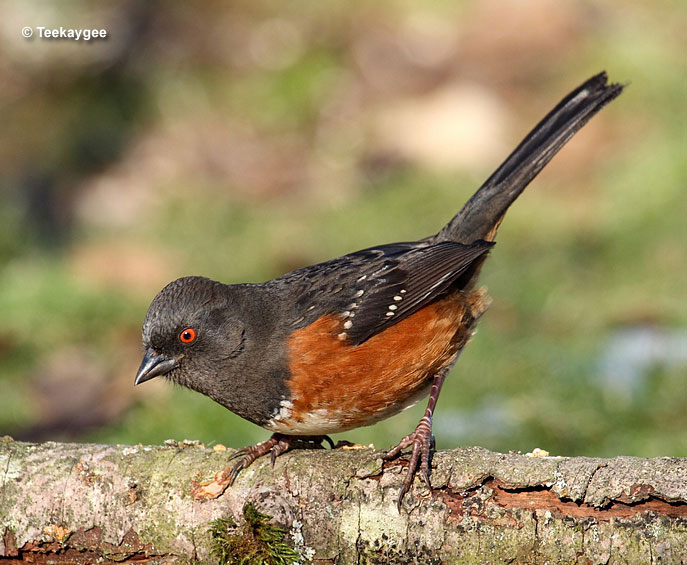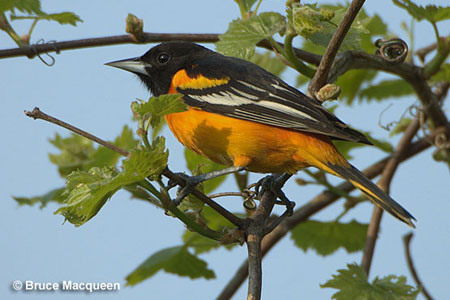
The birds of Maryland are 461 fantastic species that chirp, soar, and breed in this lovely state! From the beautiful Appalachian forests in the west to the quiet marshes and scenic waters of the Chesapeake Bay, Maryland is a wonderful place for birds and the people who watch them.
With so many birds to see in Maryland, identifying them can be a challenge!
To help, we made an accurate list of the most common backyard and wild Maryland birds.
On this page
- Most common birds of Maryland
- Northern Cardinal
- Carolina Wren
- Blue Jay
- American Crow
- Mourning Dove
- American Robin
- Tufted Titmouse
- Carolina Chickadee
- Red-bellied Woodpecker
- Downy Woodpecker
- American Goldfinch
- Song Sparrow
- White-breasted Nuthatch
- European Starling
- Eastern Bluebird
- Turkey Vulture
- Canada Goose
- White-throated Sparrow
- Northern Mockingbird
- House Finch
- House Sparrow
- Red-winged Blackbird
- Mallard
- Northern Flicker
- Gray Catbird
- Great Blue Heron
- Dark-eyed Junco
- Fish Crow
- Common Grackle
- Chipping Sparrow
- Red-shouldered Hawk
- Bald Eagle
- Pileated Woodpecker
- Black Vulture
- Eastern Towhee
- Frequently Asked Questions
Most common birds of Maryland
We used eBird data to find out which species were the most commonly seen birds and then arranged them from most common to least common.
Remember that the species at the bottom of the list are common birds too!
To help identify these common birds of Maryland, we also included up-to-date about their field marks and behavior.
Northern Cardinal
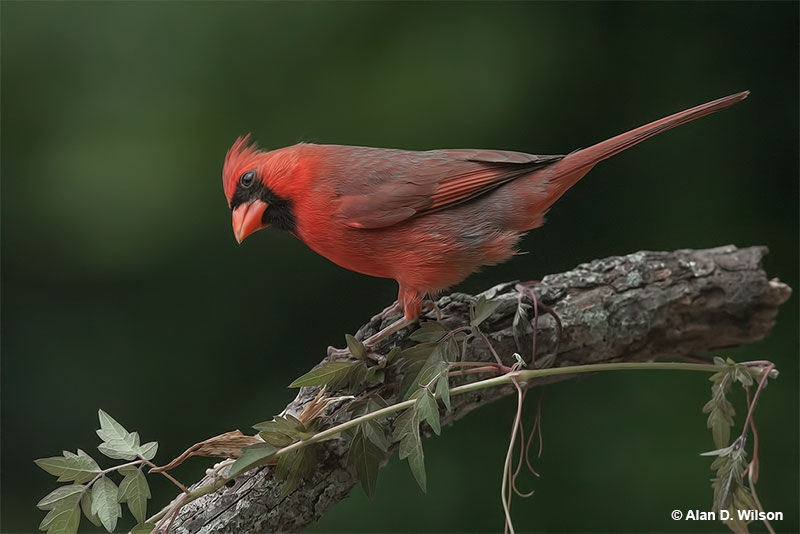
Scientific name: Cardinalis cardinalis
Length: 8.75 inches
Weight: 1.6 ounces
Wingspan: 12 inches
Song: “pichew-pichew-pichew, chew,chew,chew,chew,chew”
Northern Cardinals are medium-sized songbirds with a perky crest and big orange-red beak. Males are bright red with a black throat and face, and have dusky red on their back, wings, and tail.
Female Northern Cardinals are grayish-brown and buff with some black on their face and throat. They also have red highlights on their crest, wings, and long, rounded tail.
This species has short, rounded wings and seems to bounce up and down as they move through the air. In flight, Northern Cardinals also make sharp chip notes.
It eats seeds, insects, and some fruit and is a regular visitor to bird feeders. They forage on and near the ground, but males sing from a prominent perch.
This beautiful bird occurs in pairs and nests in bushes and low trees. It is common in the eastern and southwestern USA, southern Ontario, and in Mexico.
Carolina Wren
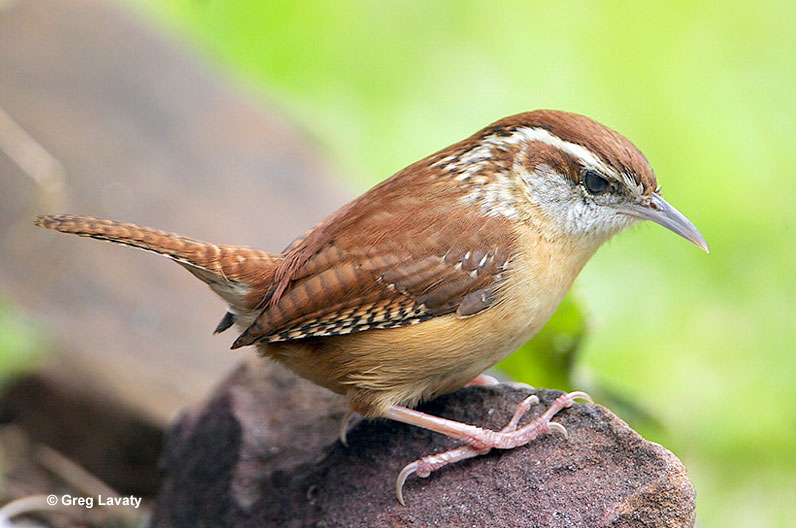
Scientific name: Thryothorus ludovicianus
Length: 5.5 inches
Weight: .74 ounces
Wingspan: 7.5 inches
Song: “teakettle, teakettle, teakettle”
The Carolina Wren is a small, reddish-brown and buff bird with a long, sharp, slightly decurved beak. It has a long, narrow, white eyebrow, a white throat, and some white mottling on its face. Males and females are similar and have black barring on their short wings, long tail, and under the tail.
Juveniles are similar but have paler underparts. This animated and vocal little bird forages for bugs in vine tangles and other dense vegetation. It usually occurs in pairs that can easily hide in the dense vegetation they prefer.
Carolina Wrens build a domed, cup nest made of sticks and soft vegetation. There is a side entrance and it can be placed in cavities and crevices of stumps, bushes, trees, potted plants, and other structures.
The Carolina Wren lives in vegetated gardens, second growth, parks, and similar habitats in much of the eastern USA, parts of southern Ontario, and parts of eastern Mexico.
Blue Jay
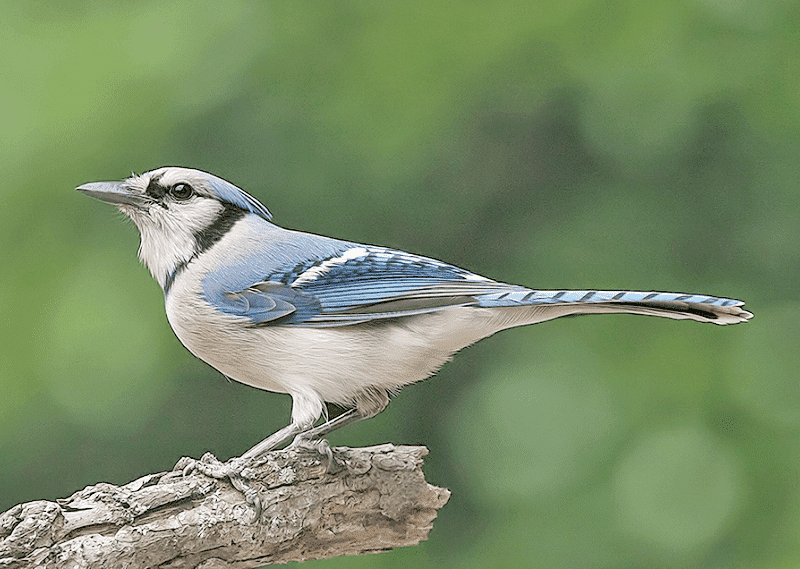
Photograph © Alan Wilson.
Scientific name: Cyanocitta cristata
Length: 11 inches
Weight: 3 ounces
Wingspan: 16 inches
Song: “Nyeah! Nyeah! Nyeah!”
The Blue Jay is a fairly large, crested bird with a straight black bill. Both sexes look alike and are blue above and gray and white below. They also have some small black lines on their faces and a narrow black necklace that goes up to the side of their face and crest.
Blue Jays also have some white markings and black barring in their wings and on their tail. Young birds look like adults but are duller blue.
They make messy cup nests at various heights in a variety of trees.
These social and intelligent birds feed on acorns, nuts, insects, and other small creatures. Like other members of the jay and crow family, they eat the eggs and nestlings of other birds.
The Blue Jay is a common bird of woodlands, forests, and towns east of the Rocky Mountains in the USA and central and southern Canada.
American Crow

Scientific name: Corvus brachyrhynchos
Length: 17.5 inches
Weight: 1 pound
Wingspan: 39 inches
Song: “Caw! Caw!”
The American Crow is a big, all black bird with a strong, stout bill. In certain lighting, it can have metallic purple and blue iridescence.
Both sexes look the same and have some feathering on their beaks, long, broad wings, and a broad tail.
American Crows have a direct flight with strong, steady wing beats. Crows are very social and intelligent birds that are usually seen in flocks. They forage together on the ground or in trees and eat just about anything they can find.
Some of their more regular foods include carrion, fruit, nuts, seeds, insects, and small animals. Like most jays and crow species, they also eat the eggs and nestlings of other bird species.
This species builds bulky stick nests high in trees and lives in most habitats except for high mountains and arid zones.
The American Crow occurs in southern Alaska and much of Canada and the USA.
Mourning Dove
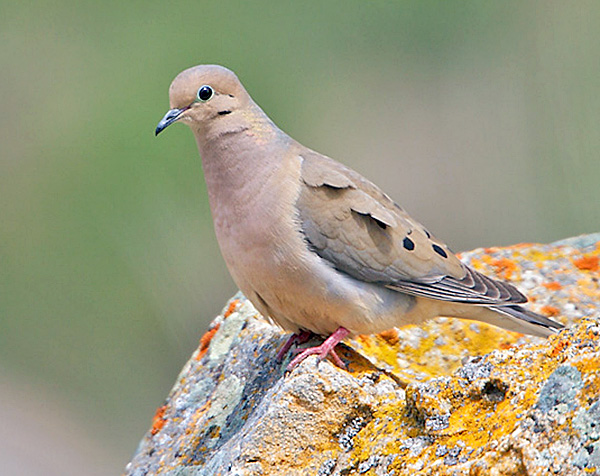
Photograph © Greg Lavaty.
Scientific name: Zenaida macroura
Length: 12 inches
Weight: 4.2 ounces
Wingspan: 18 inches
Song: “hooOOA, hoo, hoo, hoo”
Mourning Doves are medium-sized, grayish-brown doves with long tails. They have small black spots on their wings and a small head with a slender, dark beak.
Males and females also have narrow gray eyerings, a black mark on the face, and pale iridescent gold on the sides of their necks. They look alike except for males having more gray on the head and neck, and more iridescence.
This dove has fairly long wings and swift, direct flight. When flying, it shows black and white in its tail.
The Mourning Dove occurs in woodlands, gardens, on farms, and in urban areas. This common feeder visitor eats seeds and grains. It also forages in open situations, picking food from the ground.
This pleasant dove species can visit a feeder on its own or forage in small flocks. It builds an unkempt stick nest in bushes and trees and is very common throughout the USA, southern Canada, and Mexico.
American Robin
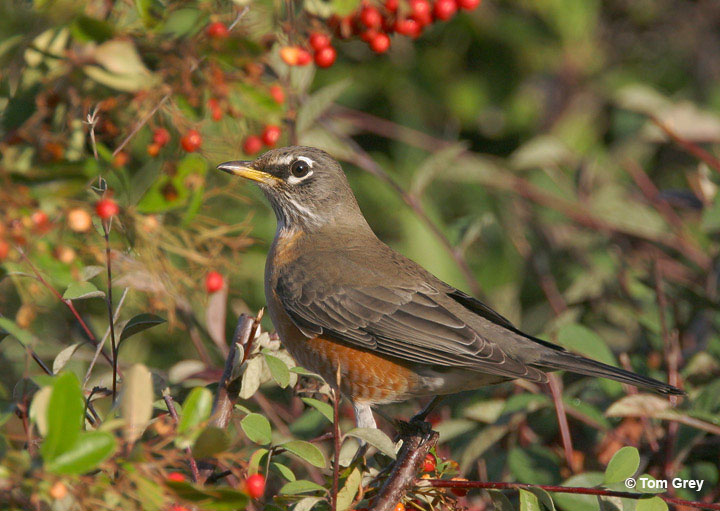
Photograph © Tom Grey
Scientific name: Turdus migratorius
Length: 10 inches
Weight: 2.7 ounces
Wingspan: 17 inches
Song: “cheery, cheery, cheery, cheery, cheer, cheer”
The American Robin is a familiar and common thrush that is dark gray above and brick red below. It also has an orange-yellow bill, a blackish head with white markings around the eyes and on the throat, and a white belly.
Both sexes of this thrush species are similar but males are darker above and more reddish on the underparts. Young American Robins have more white marks on their faces and spotting on orange underparts.
In flight, this common thrush in Maryland also shows white corners in its outer tail feathers.
American Robins forage on the ground for worms, insects, snails, and other small creatures. In winter, these common birds flock together and perch in trees and bushes to eat berries and fruit.
The American Robin makes a cup nest in trees and lives in parks, woodlands, towns, and many other habitats. They reside in Alaska, most of Canada, the USA, and in Mexico.
Tufted Titmouse
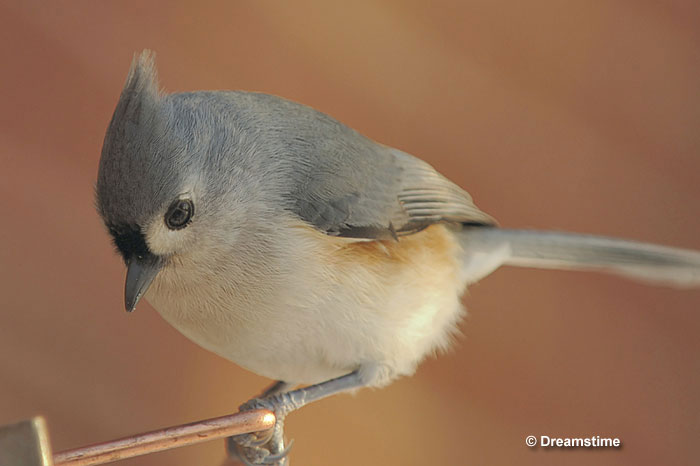
Scientific name: Baeolophus bicolor
Length: 6.5 inches
Weight: .75 ounces
Wingspan: 9.75 inches
Song: “peter peter peter”
The Tufted Titmouse is a small, crested, blue-gray bird with a white face. Males and females look the same and have a small black mark above their stubby black beak. They also have pale underparts with peach-orange flanks.
These cute little birds occur in small groups that forage for insects and seeds in parks and woodlands. They move through the trees and use their bills to pick food from leaves, bark, and branches. Tufted Titmouse are also regular visitors to bird feeders.
These small birds nest in woodpecker holes and other cavities in dead trees, and can also use nest boxes.
We find the Tufted Titmouse in hardwood forests and forested urban areas. They are often heard before they are seen, and flock with other small birds. When they see a predator, they are some of the first birds to harass it.
The Tufted Titmouse occurs in the eastern USA and some parts of southeastern Canada.
Carolina Chickadee
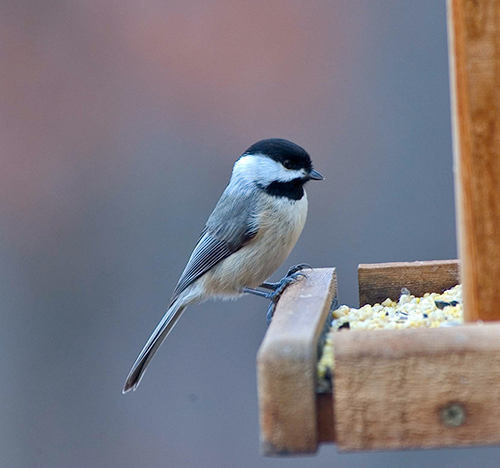
Scientific name: Poecile carolinensis
Length: 4.75 inches
Weight: .37 ounces
Wingspan: 7.5 inches
Song: “see-dee, see-dew”
The Carolina Chickadee is a small, cute, grayish and buff bird with a black cap, black throat, and white face. Males and females look the same and have stubby black beaks, strong, blue-gray legs and feet, and some pale edging on the feathers in their wings and tails.
This small bird mostly feeds on insects and seeds. It finds food by foraging with flocks of other small birds and picking small bugs and other items from bark, foliage, and twigs. Carolina Chickadees often hang upside down from twigs while foraging and are regular visitors to bird feeders.
These fun little birds nest in tree cavities and nest boxes and live in parks, woodlands, and other habitats. As long as enough trees are present, they also commonly live in urban areas.
The Carolina Chickadee is a permanent resident from Maryland and Ohio west to Texas, and south to northern Florida.
Red-bellied Woodpecker
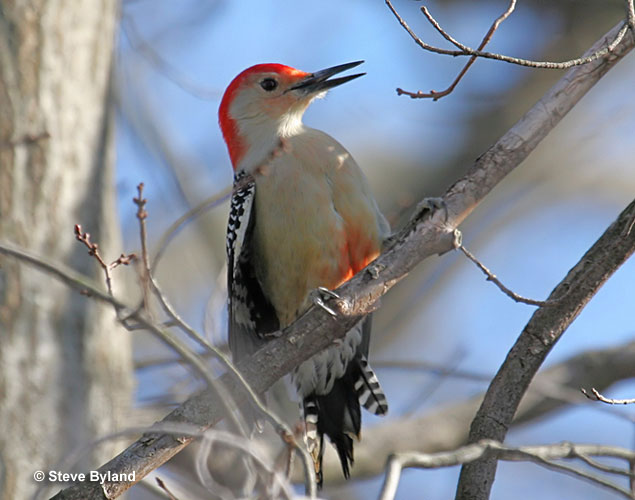
Scientific name: Melanerpes carolinus
Length: 9.25 inches
Weight: 2.2 ounces
Wingspan: 16 inches
Song: “Qwerr!”
Red-bellied Woodpeckers are medium-sized with black and white barring on their back and wings. They have a long beak and pale gray underparts with a small red patch on the belly.
Males have red on the head from the bill to the back of the neck (the nape). Females have an orange-red spot above their bill and red on the back of their head. Both sexes have a mostly white rump and central tail feathers.
This woodpecker species has long wings and “undulating” flight, where it moves up and down as it flies. In flight, Red-bellied Woodpeckers show a small white patch in their wings.
The Red-bellied Woodpecker lives in wooded habitats. It eats nuts, seeds, insects, fruit, and can attack nestlings of other species. It also visits bird feeders.
This striking woodpecker occurs in pairs and nests in tree cavities high above the ground. It is common in the eastern USA and parts of southern Ontario.
Downy Woodpecker
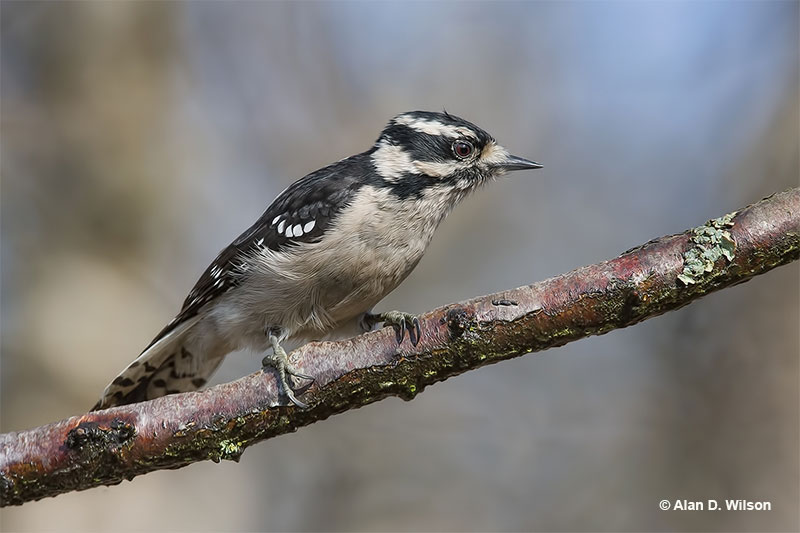
Scientific name: Dryobates pubescens
Length: 6.75 inches
Weight: .95 ounces
Wingspan: 12 inches
Song: “Pik! Ch,ch,ch,ch,ch,ch,ch!”
The Downy Woodpecker is a small black and white woodpecker with a short, black beak. They are patterned black and white above and have white backs and white underparts. Both sexes look alike except that males have a small, bright red patch on the top back part of their head.
Young birds look like adults but have a reddish patch on the top of their heads. Downy Woodpeckers also have a few small black marks in their white outer tail feathers, and a small white tuft at the base of their beak.
This woodpecker eats insects, other small creatures, seeds, and small fruits. It pecks into live and dead wood and often forages on smaller branches and twigs. These friendly little woodpeckers are also common feeder birds.
See more: Most common woodpeckers in Maryland
They nest in tree cavities and live in gardens and a wide variety of woodlands. We see Downy Woodpeckers in much of Canada and the USA but not in arid habitats.
American Goldfinch
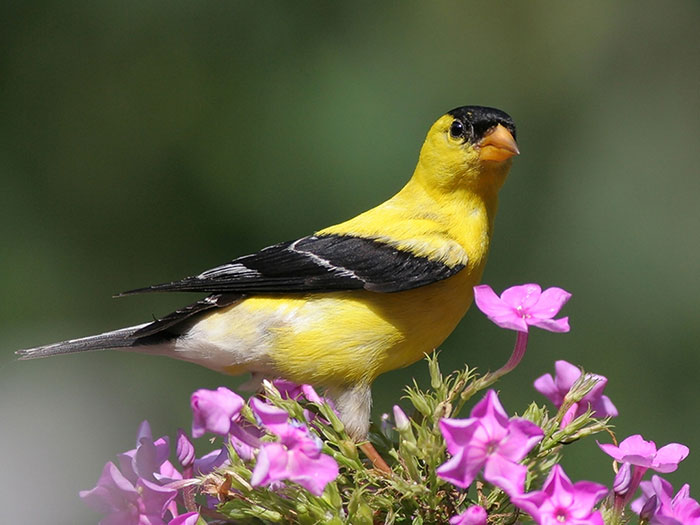
Scientific name: Carduelis tristis
Length: 5 inches
Weight: .46 ounces
Wingspan: 9 inches
Song: “swit sweet, sipsipsipchichisweetsweet”
The American Goldfinch is a small, sparrow-sized finch with a black and white, slightly forked tail, pale rump, and white undertail. In summer, males are bright lemon yellow with a small black cap, pale bill, and have some white markings on long black wings.
Females and wintering birds have two pale wings bars and have plain gray, buff, and yellowish plumage. This species often occurs in small flocks and has bounding flight.
American Goldfinches feed on seeds. They forage by picking them from grass, thistle, other low plants, Alders, and other trees. Goldfinches are also frequent visitors to bird feeders.
The American Goldfinch uses plant matter and other soft materials to build a small, tightly woven cup nest high in a shrub or a low tree.
American Goldfinches are summer residents in southern Canada, California, and the northern half of the USA, and winter in most of the USA and parts of Mexico.
Song Sparrow
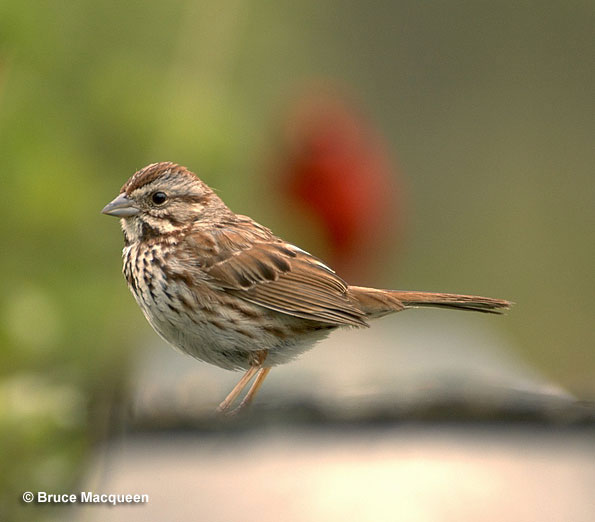
Scientific name: Melospiza melodia
Length: 6.25 inches
Weight: .7 ounces
Wingspan: 8.25 inches
Song: “seet serate sitsziziziziziziziz seet”
The Song Sparrow is a small, gray and brown streaked songbird with a thick dark mark on each side of its white throat. Males and females look the same and have white underparts with a dark brown mark on their breast, and dark brown streaks on their breast and sides.
Most Song Sparrows also have two narrow wing bars and show a rounded tail when fluttering between bushes.
This species feeds on insects, seeds, and small fruits. Pairs forage by picking up food items on and near the ground. They are also frequent visitors to bird feeders.
Song Sparrows use grass, stems, hair, and other materials to make a cup nest placed on or near the ground. They nest in dense vegetation, shrubbery, or low trees, often near water.
This species uses a wide variety of brushy habitats in open and wooded situations in southern Alaska, most of Canada, and all of the USA.
White-breasted Nuthatch
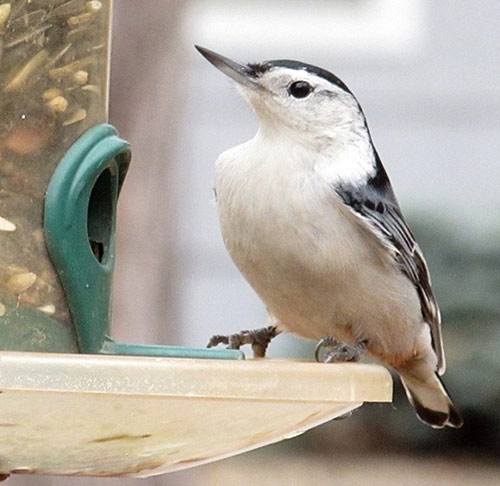
Scientific name: Sitta carolinensis
Length: 5.75 inches
Weight: .74 ounces
Wingspan: 11 inches
Song: “wehn wehn wehn wehn wehn wehn wehn wehn”
The White-breasted Nuthatch is a sparrow-sized bird with a longish, sharp, slightly upturned beak and a short black and white tail. It also has long wings, is mostly blue-gray above, and white and gray below with some chestnut on its belly and undertail.
Both sexes look similar and have a white face, but males have a black cap and nape. Females have gray on their heads and nape.
This small bird forages for insects, nuts, and seeds by creeping along branches and going down trunks, head-first. It uses its beak to pick food items from bark and also visits feeders.
The White-breasted Nuthatch makes a cup nest out of grass and soft bark inside a tree cavity or nest box.
White-breasted Nuthatches live in various wooded habitats in parts of southern Canada, most of the USA, and mountains in Mexico. They are frequent visitors to gardens near woodlands.
European Starling
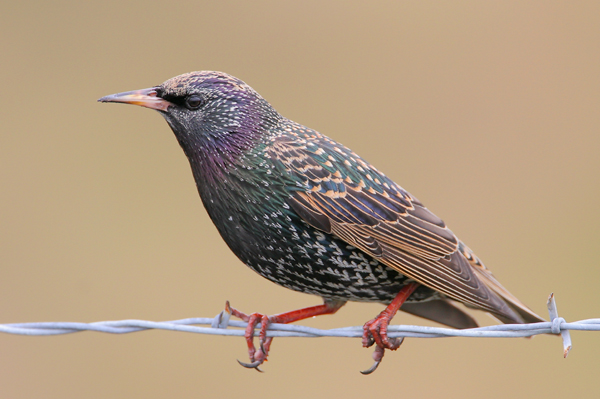
Photograph © Greg Lavaty.
Scientific name: Sturnus vulgaris
Length: 8.5 inches
Weight: 2.9 ounces
Wingspan: 16 inches
Song: “tiktiktitZHREEree..tiktiktik..ZHREE”
European Starlings are plump, short-tailed birds with long sharp beaks and longish, pointed wings. In summer, they have yellow beaks, glossy black plumage with purple and green highlights, and some small white spots.
Males and females are similar but males have less spotting and glossier plumage. In winter, they have black beaks, white spots, and more reddish colors in their wings.
Young starlings are shaped like adults but are grayish birds with a dark beak and a pale throat.
This species feeds on a variety of insects, fruit, and seeds. They can dominate bird feeders and are common species in urban areas, parks, farmlands, and other open habitats.
This European Starling builds a soft cup nest in a tree cavity, nest box, or suitable cavity in other structures.
European Starlings flock with each other and blackbird species, especially during the winter. They live across a large part of Canada and the USA.
Eastern Bluebird
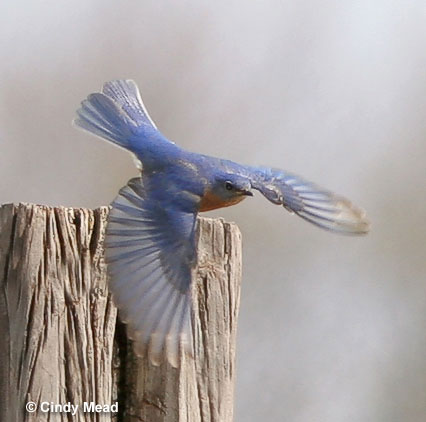
Scientific name: Sialia sialis
Length: 7 inches
Weight: 1.1 ounces
Wingspan: 13 inches
Song: “fer fer chidip fer”
The Eastern Bluebird is a rather small, blue and white bird with orange on the side of its neck, throat, breast, and flanks. The male has beautiful pastel blue upperparts, and a white belly and undertail.
Females have blue-gray upperparts, a broken white eyering, and some white on the throat.
Juveniles are gray-brown with some blue and pale spotting.
The Eastern Bluebird feeds on insects, fruit, and occasional seeds. It snatches insects in flight, picks them from leaves while hovering, and flies down to meadows and grassy areas to catch them on the ground.
Flocks of Eastern Bluebirds feed on small fruits by perching in fruiting trees and picking them from vegetation.
Eastern Bluebirds make a shallow cup nest out of grass inside a tree cavity or nest box.
This beautiful bird lives in open and semi-open habitats in southern Canada and the USA east of the Rocky Mountains. They also live in the mountains in Mexico and northern Central America (including Maryland).
Turkey Vulture
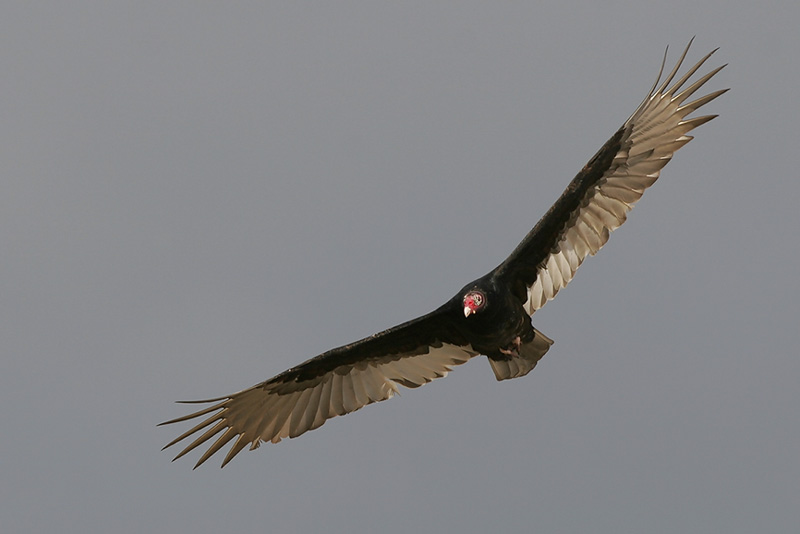
Scientific name: Cathartes aura
Length: 26 inches
Weight: 4 pounds
Wingspan: 67 inches
Song: “hisss”
The Turkey Vulture is a big, dark brownish-black raptor with a small red head and long, broad wings. Males and females look alike and also have a longish tail.
In flight, the way Turkey Vultures soar is one of the best ways to recognize them. They fly with their wings held in a “V” shape and, when gliding, often rock back and forth.
Their flight feathers are also paler than the rest of their wings, but they lack the Black Vulture’s white wing patch.
Turkey Vultures are scavengers, and most of their diet is carrion. They eat road kill and a wide variety of dead animals. This species forages over every type of habitat and can also fly over urban areas.
It lays two eggs on the ground in caves and hollow logs.
The Turkey Vulture lives in southern Canada and in most of the USA south to southern Argentina.
Canada Goose
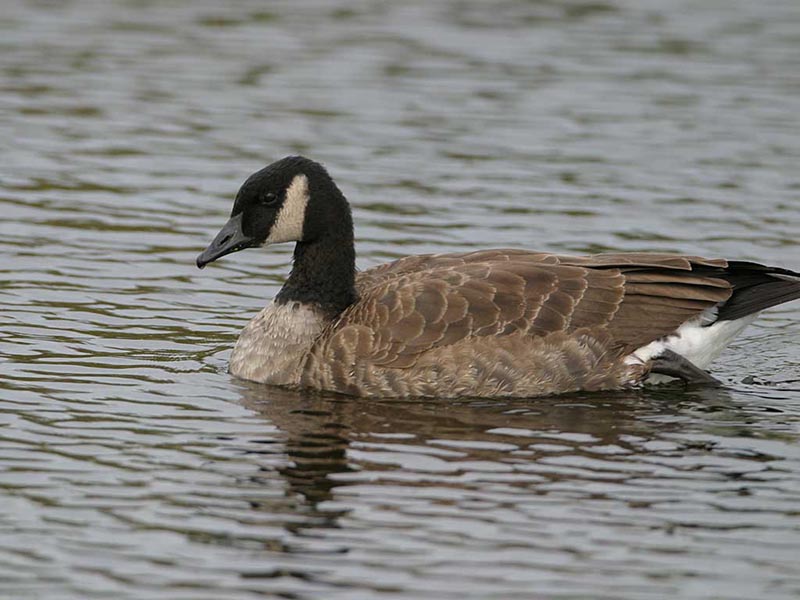
Scientific name: Branta canadensis
Length: 35 – 45.2 inches
Weight: 5.29 – 19.8 pounds
Wingspan: 50 – 67 inches
Song: “uurrRUNK! uurrRUNK!”
The Canada Goose is a large, grayish-brown bird with a long black neck, and black head with a white throat and cheeks. Males and females look alike and have pale barring, a white belly and undertail, and a short black and white tail.
They have strong direct flight and make deep flaps with long, broad wings.
Canada Geese feed on grass, sedges, and other vegetation, grain, and berries. They forage by walking along and grazing, or picking food from the ground and bushes. This species also feeds by dipping its head below the surface of shallow water.
This large goose uses grass and other plants to make a large, shallow cup nest on a small mound or other elevated spots next to water.
The Canada Goose prefers open grassy areas and farm fields near water where it can feed and see predators before they get too close. They live in Alaska, most of Canada, and most of the USA, being one of the most common birds of Maryland.
White-throated Sparrow
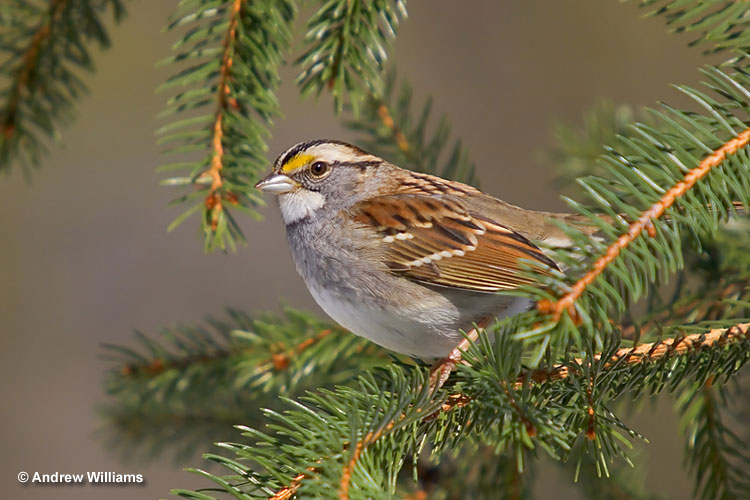
Scientific name: Zonotrichia albicollis
Length: 6.75 inches
Weight: .91 ounces
Wingspan: 9 inches
Song: “Ohhh Canada Canada Canada”
The White-throated Sparrow is a chunky, gray and brown sparrow with a white throat, and black and white stripes on its head. It has dark streaks on its back, a gray rump, and a bit of yellow in front of its eyes.
Males and females look the same and have reddish-brown wings with two white wing bars. Young White-throated Sparrows and some adults are duller brown with tan stripes on their heads and a dingy white throat.
White-throated Sparrows forage for seeds and insects on the ground, and also eat fruits in short trees and bushes. They reveal hidden food items by using their feet to scratch and kick away leaves.
This sparrow breeds in northern forests and builds a cup nest with grass and twigs. They construct the nest at the edge of the forest, on or close to the ground, in dense vegetation.
These sparrows usually occur in flocks and winter in the eastern and southwestern USA and parts of California.
Northern Mockingbird
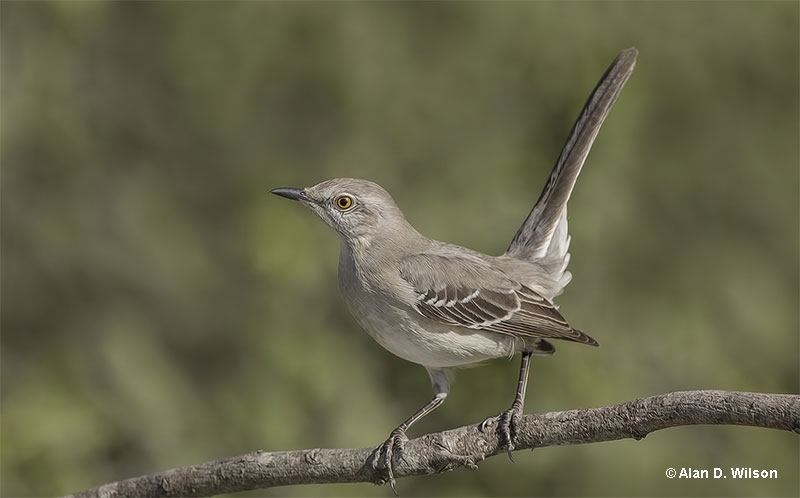
Scientific name: Mimus polyglottos
Length: 10 inches
Weight: 1.7 ounces
Wingspan: 14 inches
Song: “kerdee, kerdee, kerdee…jirdle,jirdle,jidrle…”
The Northern Mockingbird is a pale gray and white bird with a long tail. Around the same size as an American Robin, it has a dark line through a pale eye, a short, slender beak, and two white wing bars.
Both sexes look alike, are gray above and white and buff below. In flight, this bird shows a blackish tail with white outer feathers and a big white wing patch.
Northern Mockingbirds feed on insects and berries. They forage in open grassy spots on the ground. These animated birds run and pick bugs from the ground and fly up to catch insects in flight. In winter, they also perch in bushes to feast on berries.
The Northern Mockingbird lives in towns, parks, and other semi-open habitats and builds cup nests in bushes and low trees. Northern Mockingbirds are common garden birds in much of the eastern and southern USA, southern Ontario, and Mexico.
House Finch
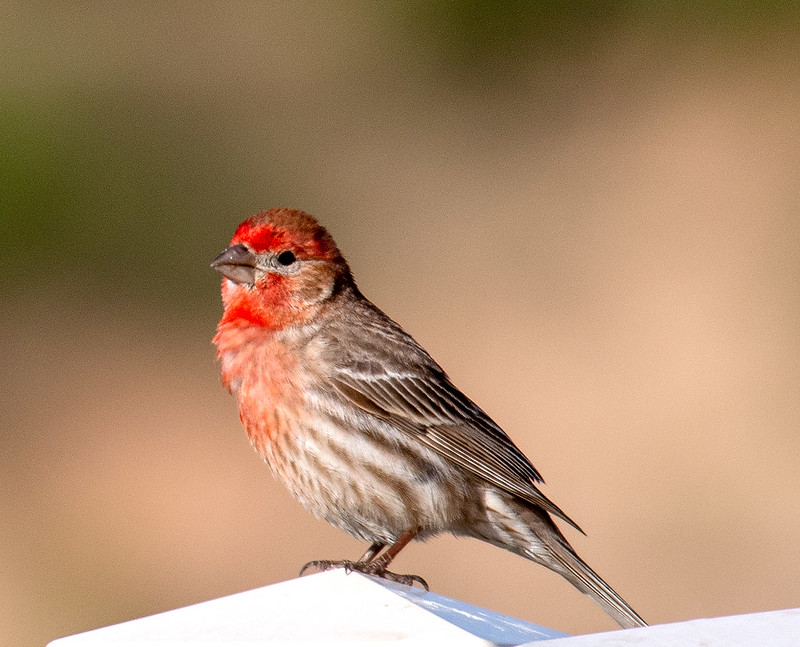
Photograph © John Hansen
Scientific name: Haemorhous mexicanus
Length: 6 inches
Weight: .88 ounces
Wingspan: 10 inches
Song: “chip,chip,chiprididip,ZREEYachip”
House Finches are sparrow-sized birds with dark, rounded beaks and fairly long wings. Males are orange-red or rose-red on their head, throat and breast, and have some red on their rump. They also have brownish streaks on their back, flanks, and white belly.
Like the male, female House Finches have two white wing bars on long, gray-brown wings. However, they lack red and are mostly streaked, dull brown-gray birds.
House Finches feed on seeds, buds, fruit, and flowers. They often visit feeders in Maryland but also forage on the ground and in bushes and trees.
We see these pretty birds in deserts and arid zones and in parks, farmland, urban areas, and other semi-open habitats.
The House Finch makes a soft cup nest built on a tree, building ledge or other spot with some overhanging cover. They often occur in small groups and live in southern Canada, most of the USA, Mexico, and Hawaii.
House Sparrow
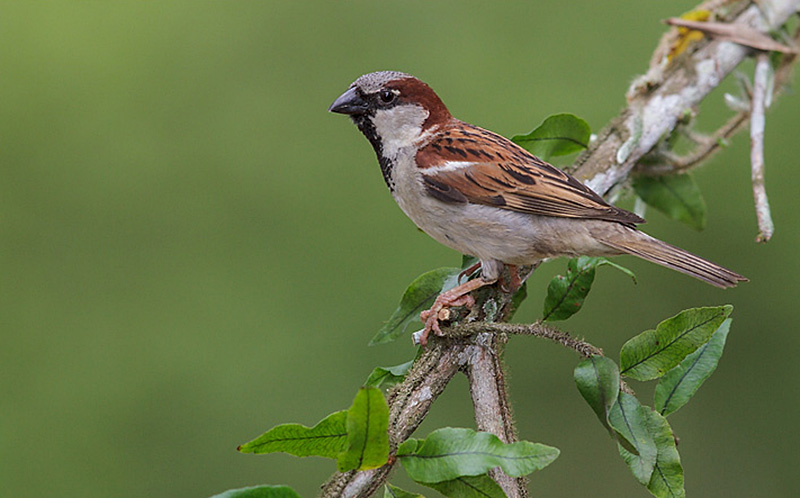
House Sparrow (Passer domesticus) perched on a branch in the Atlantic rainforest of southeast Brazil.
Scientific name: Passer domesticus
Length: 6.25 inches
Weight: .98 ounces
Wingspan: 9.5 inches
Song: “see,chirrup,see,chirrup,see,chirrup”
House Sparrows are small, plump gray and brown birds with conical, finch-like beaks. Males have a gray and rufous head with pale cheeks, and black near their eyes and on their throat.
The rest of their underparts are gray and they have brown, streaked backs with rufous highlights. They also have a white mark in the shoulder of each wing and a grayish rump and tail.
Females are plainer brown and buff, have paler beaks, and buff eyebrows.
House Sparrows feed on seeds, grain, and insects. They are regular visitors to bird feeders and often dominate other smaller species. They also forage on the ground in farmlands, parks, urban areas, and other open situations.
The House Sparrow nests in cavities. When searching for suitable nesting sites, they can kill and remove the eggs and young of smaller species like Eastern Bluebirds.
House Sparrows usually live near people and occur in most of North America, including Maryland.
Red-winged Blackbird
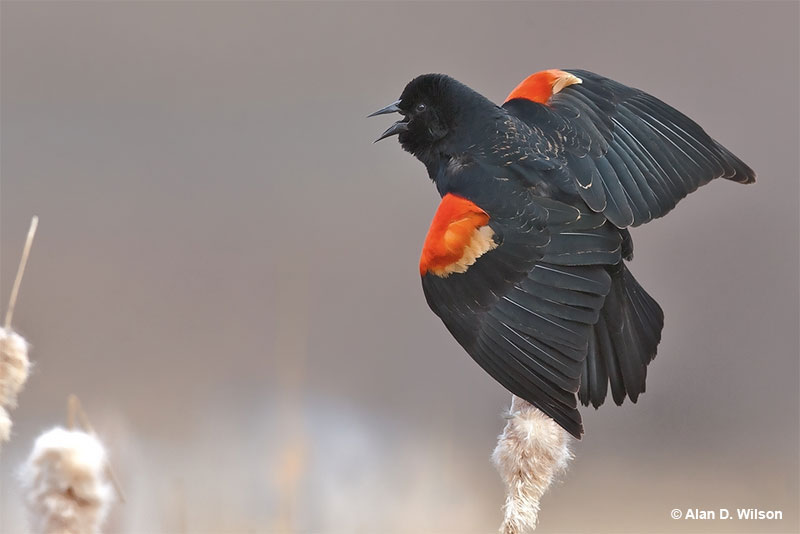
Scientific name: Agelaius phoeniceus
Length: 8.75 inches
Weight: 1.8 ounces
Wingspan: 13 inches
Song: “kan-keree!”
The Red-winged Blackbird is a medium-sized blackbird species with a sharp, all-black bill. Males also have a scarlet patch with a pale yellow border on the shoulder of each wing.
Female Red-winged Blackbirds are dark, heavily streaked, brownish-gray birds with an orange-buff eyebrows and throat. She can also have a little bit of dingy red on her shoulder.
Red-winged Blackbirds often flock together and can form very large groups in the winter. They feed on seeds, grain, and insects found on lawns, in marshes, farm fields, and other open habitats.
This species builds a cup nest made of leaves and dead stems in a bush or other low vegetation in a marsh, park, or brushy field.
Red-winged Blackbirds are very common birds that live in all sorts of open habitats. We see them in parks, farming areas, and marshes in much of Canada, the USA, Mexico, and parts of the Central America.
Mallard
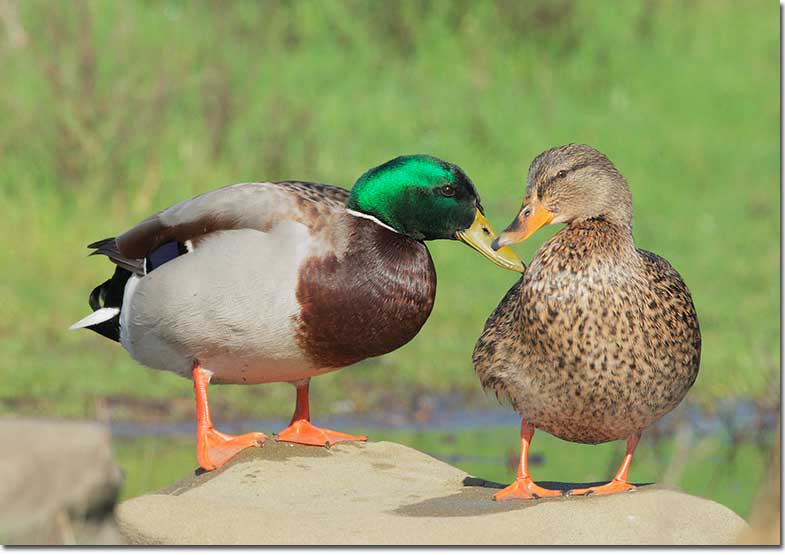
Mallard pair (Male and female)
Scientific name: Anas platyrhynchos
Length: 23 inches
Weight: 2.4 pounds
Wingspan: 35 inches
Song: “quack, quack”
The Mallard is a fairly large, familiar duck. The male has a metallic green head, yellow bill, narrow white ring around the neck, and chestnut breast. The rest of the bird is pale gray with pale brown, and black on its back and around his tail.
Female Mallards are mottled brown and buff with a dark crown and line through the eyes, and have a dark gray and orange beak.
In flight, both sexes show a green-blue wing patch bordered with white.
Mallards eat a variety of items, including insect larvae, snails, other small aquatic creatures, acorns, seeds, and grain. They forage by filtering and picking up food items in and near shallow water, and in farm fields.
This Maryland duck species makes a shallow nest with sticks and lined with down feathers. It builds its nest on the ground, hidden in grass or under a bush.
The Mallard lives in ponds, marshes, and many wetland habitats in Canada, USA, and Eurasia.
Northern Flicker
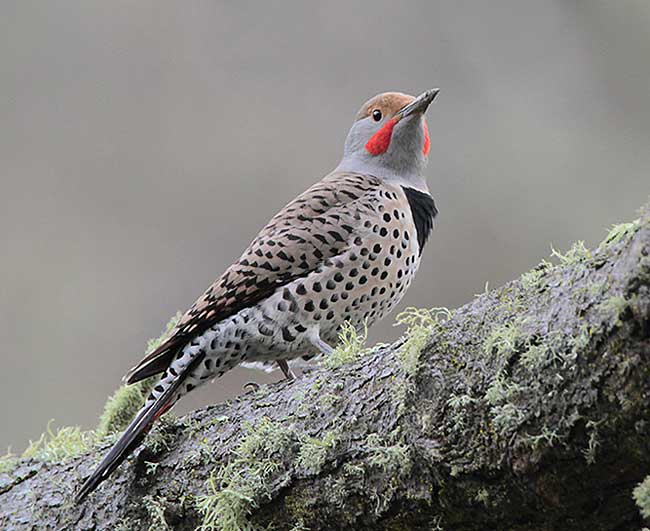
Scientific name: Colaptes auratus
Length: 12.5 inches
Weight: 4.6 ounces
Wingspan: 20 inches
Song: “kick,kick,kik,kik,kik.kik.kik.kik.kik.kik.kik.kik!”
Northern Flickers are fairly large, tan and gray woodpeckers with barring on their backs. They have a black mark on their breast, black spotting below, and a dark, stout beak.
Males in the east have a tawny throat and face with a black mustache and small red spot on the back of their heads. Males in the west have mostly gray heads with a red mustache.
Female Northern Flickers look like males but lack the mustache mark.
In bounding flight, they have white rumps and flash color on their underwings. This is bright yellow in eastern birds and reddish in flickers west of the Rocky Mountains.
This woodpecker eats many ants and other insects that it catches on the ground. It forages by flying to the ground, locating anthills, and lapping them up with its long tongue.
Northern Flickers nest in tree cavities and live in wooded and open habitats in Canada, the USA, and Mexico.
Gray Catbird
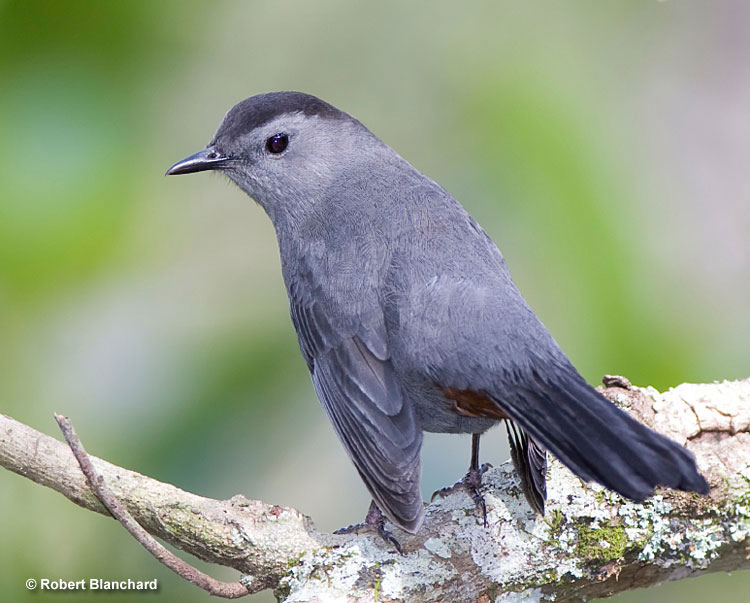
Scientific name: Dumatella carolinensis
Length: 8.5 inches
Weight: 1.3 ounces
Wingspan: 11 inches
Song: “rheah!”
The Gray Catbird is a slender, gray songbird with a black cap and chestnut under its tail. Both sexes look alike and have beady, black eyes on a gray face, a longish tail, and a smallish, black beak.
This reclusive bird feeds on insects and berries in thickets and second growth. It forages by moving through dense vegetation and picking food items from leaves and twigs.
Gray Catbirds make bulky, open cup nests constructed with grass, strips of vegetation, and hair. They build their nests in shrubs, bushes, and small trees.
The Gray Catbird is often heard before it is seen and loves to skulk in low thick vegetation. This migrant species spends summers in southern Canada, and in much of the eastern and northern USA. In fall, it migrates to coastal areas in the eastern and southern USA, and Florida south to northern South America.
Great Blue Heron
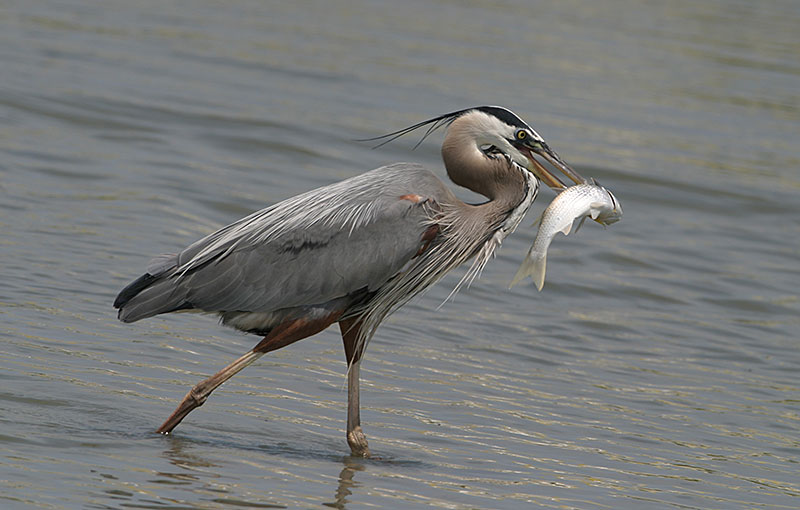
Scientific name: Ardea herodias
Length: 46 inches
Weight: 5.3 pounds
Wingspan: 72 inches
Song: “Grunk! Grunk!”
The Great Blue Heron is a large, gray and pale brown heron with a long neck and legs. It has a strong, yellowish beak, black and white head with a wispy black crest, and rufous thighs.
Both sexes are alike and have pale bellies and black flanks. Juveniles have streaked underparts.
In flight, they make slow, deep flaps with long, broad gray and black wings. In Southern Florida and the Caribbean, Great Blue Herons are all white and sometimes considered a separate species, the “Great White Heron”.
These powerful herons feed on fish and small animals such as rats, snakes, and birds.
Great Blue Herons build messy, stick nests and breed in colonies, often in swamps.
We find these impressive birds in and near a wide variety of wetlands in large parts of Canada, the USA, and the Caribbean.
Dark-eyed Junco
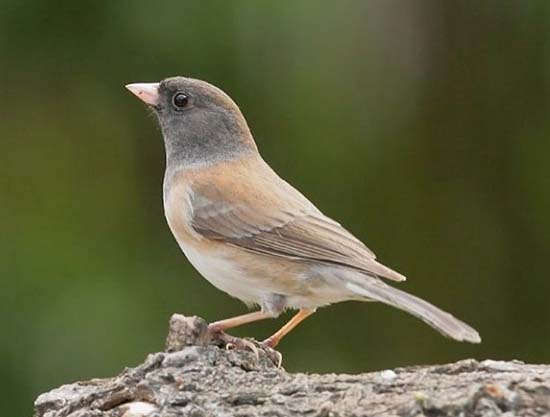
Scientific name: Junco hyemalis
Length: 6.25 inches
Weight: .67 ounces
Wingspan: 9.25 inches
Song: “sipsipsipsipsipsipsip”
Dark-eyed Juncos are sparrow-like birds with pale conical bills and dark eyes. This small bird has variable plumage, with most being slate gray or gray and brown with white on their bellies, and white under their tails.
Other plumages include birds with dark masks and faint white wing bars, juncos with pale gray hoods and pinkish sides, and birds with blackish hoods and chestnut sides.
In flight, all Dark-eyed Juncos show extensive white in their longish tails.
This species feeds on seeds, insects, and some fruit and grain. Juncos forage on the ground in wooded areas, parks, and other habitats. They also feed on fallen seed beneath feeders.
They build cup nests on the ground under fallen logs, in roots, and in other hidden spots. After breeding, juncos form flocks that forage together in similar wooded and semi-open habitats.
Dark-eyed Juncos are common birds in Canada, the USA, and parts of Mexico.
Fish Crow
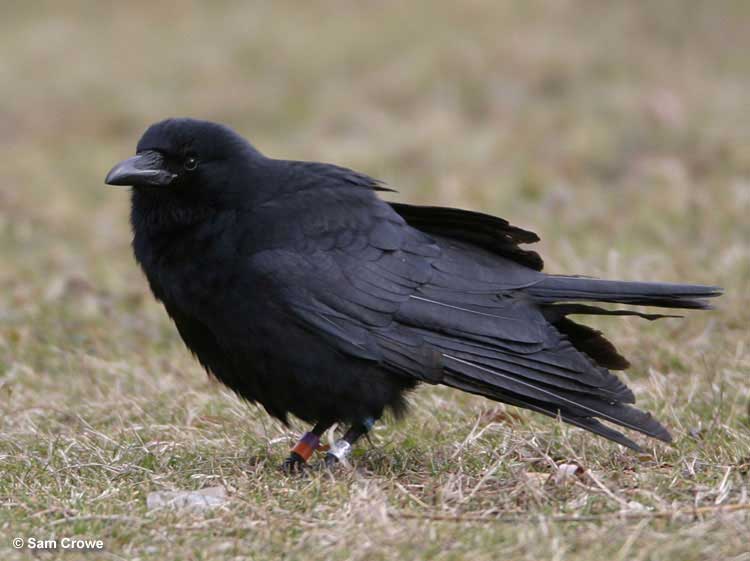
Scientific name: Corvus ossifragus
Length: 15 inches
Weight: 10 ounces
Wingspan: 36 inches
Song: “cuh”
The Fish Crow is a large, all-black bird with a stout, black beak. Both males and females look the same and have some feathers on top of their bill, long wings, and a broad tail. In certain lighting, they also show some dark blue and purple highlights.
This species feeds on small creatures and a wide variety of food items found in coastal habitats and in other wetlands. It also scavenges for carrion and preys on eggs and nestlings of other bird species.
In particular, Fish Crows are important predators at nesting colonies of waterbirds.
After breeding, Fish Crows form large flocks and, in many places, they have become adapted to living in urban areas. These birds have become used to people but don’t usually visit feeders.
They build large, messy stick nests high in trees, and only live in coastal areas and wetlands in the eastern USA.
Common Grackle
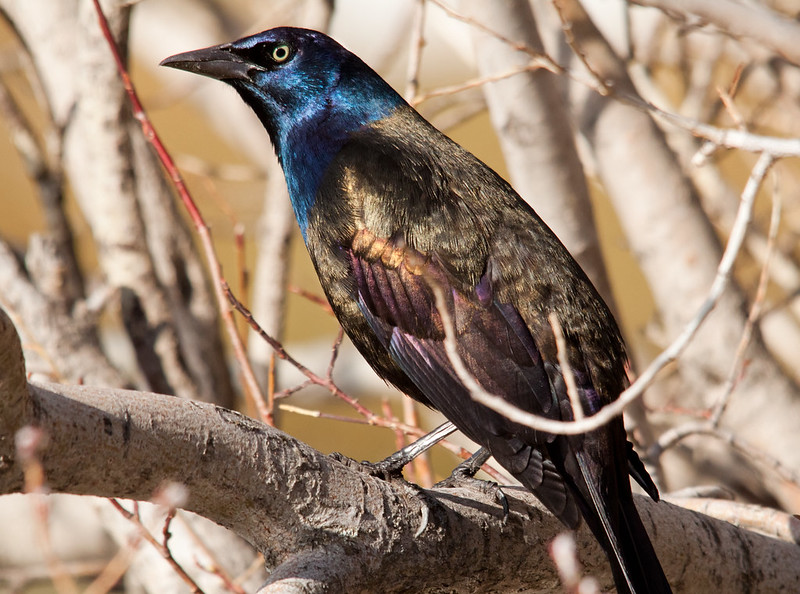
© Shawn McCready
Scientific name: Quiscalus quiscula
Length: 12.5 inches
Weight: 4 ounces
Wingspan: 17 inches
Song: “Sherink!”
The Common Grackle is a jay-sized, glossy black bird with pale eyes and a long, wedge-shaped tail. Depending on lighting, this bird shows metallic purple, blue, green, and bronze highlights.
Males and females look very similar, but females have shorter tails and less iridescence. Both sexes also have stout, black beaks, and strong, black legs and feet.
In flight, Common Grackles move up and down as they move through the air. They usually flock together and often forage in farm fields, on lawns, and in other open habitats. These omnivores feed on a variety of items, including insects, seeds, grain, small animals, garbage, and the eggs and nestlings of other birds.
Common Grackles build bulky stick nests, usually in conifers in woodlands, parks, near water, and urban areas.
This species can form big flocks in the winter and lives in a variety of semi-open and open habitats in eastern Canada and the eastern USA.
Chipping Sparrow
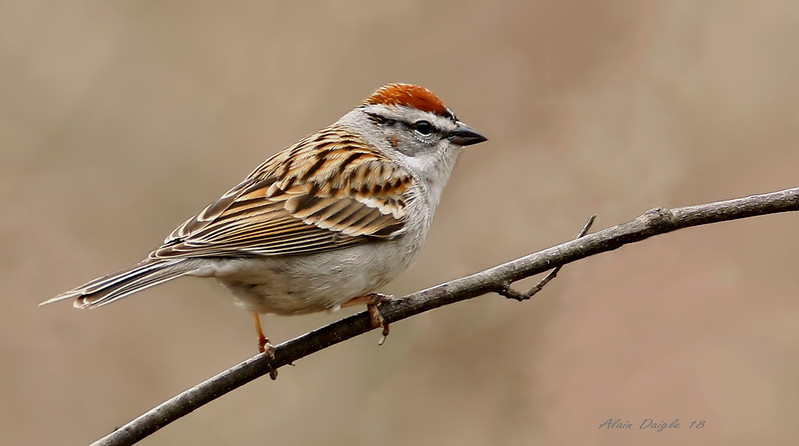
© Alain Daigle
Scientific name: Spizella passerina
Length: 5.5 inches
Weight: .42 ounces
Wingspan: 8.5 inches
Song: “titititititititititititti”
The Chipping Sparrow is a small, brown and gray sparrow with a longish, slightly forked tail and a conical bill. In summer, it has a rufous cap, white eyebrow, and dark line through each eye.
Males and females look the same and have small white crescents above and below the eyes, a pale brown back with dark streaks, gray rump and underparts, and pale brown wings with two pale wing bars.
In fall and winter, Chipping Sparrows are duller, and have brown and buff heads, a gray rump, and a dark line through their eyes.
This species forages on the ground for insects and small seeds in open, grassy areas near conifers.
Chipping Sparrows use grass, hair, and other materials to make a cup nest low in a bush or small tree.
These sparrows live in parks, open woodlands, and on golf courses in much of Canada, most of the USA, and parts of Mexico.
Red-shouldered Hawk
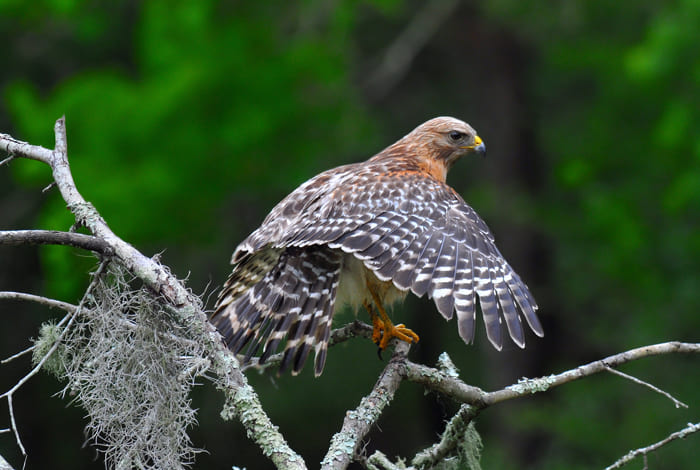
Scientific name: Buteo lineatus
Length: 17 inches
Weight: 1.4 pounds
Wingspan: 40 inches
Song: “Kyeah, Kyeah, Kyeah, Kyeah!”
The Red-shouldered Hawk is a medium-sized raptor with a black and white tail. This crow-sized hawk is dark brown and reddish above and has reddish-orange underparts.
Males and females look alike, but females are larger. This hawk also has a dark mark on each side of its throat, and black and white wings with a red shoulder. Juveniles resemble adults but are brown with dark brown streaks below.
Read more: Most Common Hawks in Maryland
In flight, Red-shouldered Hawks have long, broad wings with a pale, crescent-shaped mark on the base of their primaries.
These raptors feed on small animals, including frogs, snakes, squirrels, and occasional birds. They hunt by watching from a perch and then swooping down to catch the animal on the ground.
Red-shouldered Hawks build a bulky stick nest high in a tree and live in hardwood forest habitats. We find them in southeastern Canada, the eastern USA, and from southern coastal Oregon south to Baja California.
Bald Eagle
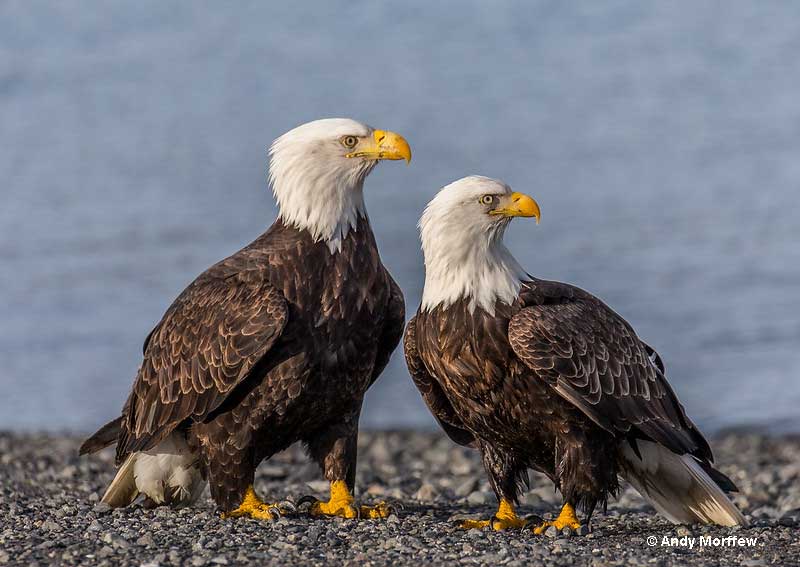
Judging by the size, female is on the left and male is on the right. Photograph © Andy Morffew
Scientific name: Haliaeetus leucocephalus
Length: 31 inches
Weight: 9.5 pounds
Wingspan: 80 inches
Song: “pip pipipipip!”
The Bald Eagle is a huge, dark brown raptor with a white head, white tail, and a big yellow beak. Males and females look the same, except that females are bigger.
Young birds are dark brown with mottled white and have a mostly dark beak.
In flight, Bald Eagles soar on broad, long wings held flat like a board. They also have deep and slow wing beats.
The Bald Eagle snatches fish from the surface of lakes, rivers, and other shallow wetlands. It also feeds on carrion and occasionally catches small mammals and birds as big as a Canada Goose.
This big raptor builds a big, bulky stick nest high in a tree in or near wetlands. They often use the same nest year after year.
Bald Eagles occur in a variety of wetland habitats in Alaska, Canada, most of the USA (including Maryland), and in some parts of northern Mexico.
Pileated Woodpecker
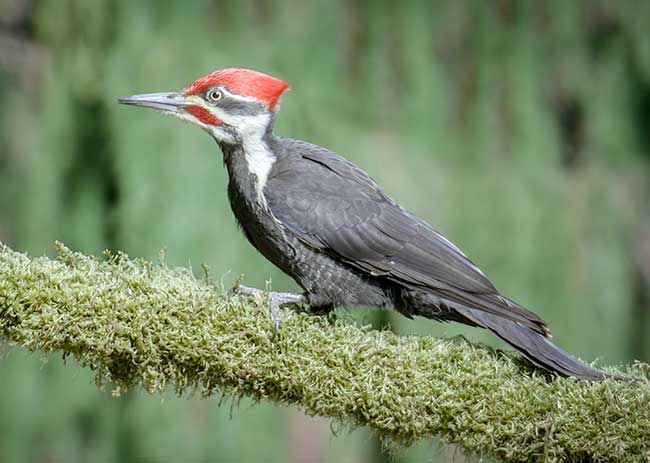
Scientific name: Dryocopus pileatus
Length: 16.5 inches
Weight: 10 ounces
Wingspan: 29 inches
Song: “kek,kek,kek,kek,kek,kek!”
The Pileated Woodpecker is a big, crow-sized black woodpecker with a pointed, red crest, and a black and white face. Males have red extending from the bill to the back of the crest and a red “moustache” mark on their face. Females only have red on the top of the crest.
Both sexes have white on each side of their necks, and a white patch on the front part of each wing. They also have a longish, pointed black tail, and, in flight, show a lot of white on their underwings.
Pileated Woodpeckers are often seen in undulating and direct flight between forest patches. In their search for carpenter ants and insects, they use their strong beaks to make rectangular holes in trees and stumps.
This species nests in tree cavities, usually high above the ground. It lives in mature woodlands in Canada, much of the eastern USA (including Maryland), and parts of the Pacific Northwest.
Black Vulture
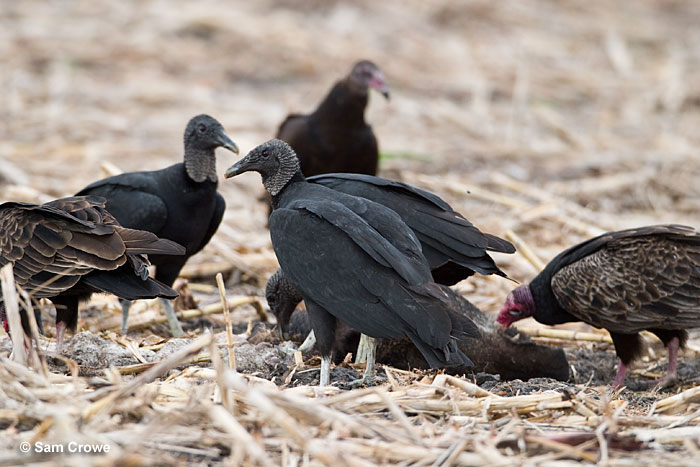
Scientific name: Coragyps atratus
Length: 25 inches
Weight: 4.4 pounds
Wingspan: 59 inches
Song: “whuf”
The Black Vulture is a big, bulky, black raptor with a naked, wrinkled black head and rather short, broad tail. It has a white patch near the tip of each of its long, broad wings, and a pale, slender beak with a hooked tip.
Male and female Black Vultures look alike and also have fairly long, blackish legs and feet. They fly with a few quick flaps followed by soaring with their wings held flat.
This species mostly feeds on carrion, but it can also catch small animals when the opportunity presents itself. Black Vultures usually feed in flocks and find their food by soaring high overhead and watching for dead animals as well as following other vultures to food sources.
The Black Vulture lays eggs on the ground inside caves, abandoned buildings, hollow logs, or other dark and protected places. It uses a wide variety of habitats from southern New York west to Arizona and south to Argentina.
Eastern Towhee
Scientific name: Pipilo erythrophthalmus
Length: 8.5 inches
Weight: 1.4 ounces
Wingspan: 10.5 inches
Song: “drink your TEA!”
The Eastern Towhee is a thrush-sized, boldly patterned, sparrow-like bird with red-brown eyes and a black, finch-like beak. It is dark above, has a small white patch in the wing, and a white belly with chestnut flanks.
It also has buff on its undertail, and white spots under its longish, rounded tail. Males have black upperparts and a black hood, while these parts on females are dark brown. Young birds are dark brown and heavily streaked. They also have a pale wing patch and a buff undertail.
Eastern Towhees forage for insects and seeds by scratching and tossing leaf litter with both feet. This species also feeds on berries, especially during the winter months.
The Eastern Towhee uses grass and other plant matter to make an open cup nest in dense vegetation on or near the ground.
Eastern Towhees frequent dense second growth and brushy habitats east of the Rockies in southern Canada and the eastern USA (being one of the most common birds of Maryland).
Frequently Asked Questions
How many bird species are native to Maryland?
In total, 461 bird species are native to Maryland.
What is the most common bird in Maryland?
The most common bird in Maryland is the Northern Cardinal. According to sightings in eBird, the Northern Cardinal has been seen more often than any other bird species in Maryland.
What is the largest bird in Maryland?
The largest bird in Maryland is the American White Pelican. This huge bird is 62 inches long and has a wingspan of nine feet! Another large bird in Maryland is the Trumpeter Swan; a bird that is 60 inches long, has an 80 inch wingspan, and weighs 23 pounds.
What is the smallest bird in Maryland?
The smallest bird in Maryland is the Calliope Hummingbird. This rare vagrant to Maryland is just 3.25 inches long.
Are there any owl species in Maryland?
Maryland is a good place for owls, there are 7, sometimes 8 species living here. The most common ones are Barred Owls and Great Horned Owls.
What is the fastest bird in Maryland?
The fastest bird in Maryland is the Peregrine Falcon. The Peregrine Falcon is also the fastest bird in the world and can fly as fast as 200 miles per hour!


